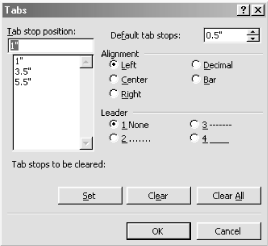Name
Format → Tabs
Synopsis
Normal.dot , the default template on which new documents are based, provides left-aligned tabs set at every half-inch across the width of a page. For most documents, these tabs are sufficient.
To set tabs at other ruler positions than the default half-inch increments or if the content at a tab stop must be centered or right-aligned, custom tabs are required. Choose Format → Tabs to open the Tabs dialog box (Figure 8-11).

Figure 8-11. Customizing tab settings by varying the alignment and adding leader characters
Before setting tabs, position the insertion point where the new tab stops should go into effect, normally at the beginning of a line. A Word document can potentially have a new set of tab stops for every paragraph. Use the Show/Hide tool and the horizontal ruler to see which tab settings are in force at different points in a document.
Don’t Use Tabs to Indent
Many people use tabs at the beginning of a paragraph as a first-line indent. I don’t recommend this. Not only will you have to press Tab at the beginning of every paragraph to indent, you will have to delete the tabs manually if you combine consecutive paragraphs. Instead, use Word’s first-line indent feature (Format → Paragraph → Indents and Spacing), described earlier in this chapter.
When the Tabs dialog box opens, click the Clear All button to remove any previous custom tab settings. ...
Get Word 2000 in a Nutshell now with the O’Reilly learning platform.
O’Reilly members experience books, live events, courses curated by job role, and more from O’Reilly and nearly 200 top publishers.

